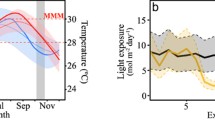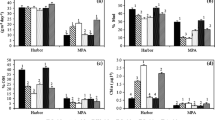Abstract
This study investigated the effects of temperature and salinity on growth, survival, and photosynthetic efficiency of three coral species, namely, Pocillopora damicornis, Acropora millepora and Platygyra sinensis of different ages (6 and 18 months old). The experimental corals were cultivated via sexual propagation. Colonies were exposed to 5 different temperatures (18, 23, 28, 33, and 38°C) and 5 different salinities (22, 27, 32, 37, and 42 psu). Results showed that temperature significantly affected photosynthetic efficiency (Fv/Fm) (p < 0.05) compared to salinity. The maximum quantum yield of corals decreased ranging from 5% to 100% when these corals were exposed to different temperatures and salinities. Temperature also significantly affected coral growth and survival. However, corals exposed to changes in salinity showed higher survivorship than those exposed to changes in temperature. Results in this study also showed that corals of different ages and of different species did not display the same physiological responses to changes in environmental conditions. Thus, the ability of corals to tolerate salinity and temperature stresses depends on several factors.
Similar content being viewed by others
References
Anthony KRN, Connolly SR, Hoegh-Guldberg O (2007) Bleaching, energetics and coral mortality risk: Effects of temperature, light, and sediment regime. Limnol Oceanogr 52:716–726
Baird AH, Hughes TP (2000) Competitive dominance by tabular corals: an experimental analysis of recruitment and survival of understorey assemblages. J Exp Mar Biol Ecol 251:117–132
Beer S, Iian M, Eshel A, Weil A, Brickner I (1998) Use of pulse amplitude modulated (PAM) fluorometry for in situ measurement of photosynthesis in two Red Sea faviid corals. Mar Biol 131:607–612
Buddemeier RW, Fautin DG (1993) Coral bleaching as an adaptive mechanism: a testable hypothesis. BioScience 43:320–326
Coles SL, Jokiel PL (1978) Synergistic effects of temperature, salinity and light on the hermatypic coral Montipora verrucosa. Mar Biol 49:187–195
Chavanich S, Viyakarn V, Loyjiw T, Pattaratamrong P, Chankong A (2009) Mass bleaching of soft coral, Sarcophyton spp. in Thailand and the role of temperature and salinity stress. ICES J Mar Sci 66:1515–1519
Chavanich S, Viyakarn V, Adams P, Klammer J, Cook N (2012) Reef communities after the 2010 mass coral bleaching at Racha Yai Island in the Andaman Sea and Koh Tao in the gulf of Thailand. Phuket Mar Biol Cent Res Bull 71:103–110
Chow AM, Ferrier-Pagès C, Khalouei S, Reynaud S, Brown IR (2009) Increased light intensity induces heat shock protein Hsp60 in coral species. Cell Stress Chaperon 14:469–476
Davies PS (1984) The role of zooxanthellae in the nutritional energy requirements of Pocillopora eydouxi. Coral Reefs 2:181–186
Edmondson CH (1928) The ecology of an Hawaiian coral reef. Bull Bernice P Bishop Mus 45:1–64
Edmunds PJ, Davies PS (1986) An energy budget for Porites porites (Scleractinia). Mar Biol 92:339–347
Fabricius KE, Mieog JC, Colin PL, Idip D, van Oppen MJ (2004) Identity and diversity of coral endosymbionts (zooxanthellae) from three Palauan reefs with contrasting bleaching, temperature and shading histories. Mol Ecol 13:2445–2458
Ferrier-Pagès C, Gattuso JP, Jaubert J (1999) Effect of small variations in salinity on the rates of photosynthesis and respiration of the zooxanthellate coral Stylopora pistillata. Mar Ecol-Prog Ser 181:309–314
Ferrier-Pagès C, Richard C, Forcioli D, Allemand D, Pichon M, Shick JM (2007) Effects of temperature and UV radiation increases on the photosynthetic efficiency in four scleractinian coral species. Biol Bull 213:76–87
Franklin DJ, Cedrès CMM, Hoegh-Guldberg O (2006) Increased mortality and photoinhibition in the symbiotic dinoflagellates of the Indo-Pacific coral Stylophora pistillata (Esper) after summer bleaching. Mar Biol 149:633–642
Frisch AJ, Ulstrup KE, Hobbs JP (2007) The effects of clove oil on coral: an experimental evaluation using Pocillopora damicornis (Linnaeus). J Exp Mar Biol Ecol 345:101–109
Hoegh-Guldberg O (1999) Climate change, coral bleaching and the future of the world’s coral reefs. Mar Freshwater Res 50:839–866
Jacques TG, Marshall N, Pilson MEQ (1983) Experimental ecology of the temperate scleractinian coral Astrangia danae II. Effects of temperature, light intensity and symbiosis with zooxanthellae on metabolic rate and calcification. Mar Biol 76:135–148
Jokiel PL, Coles SL. Gutther EB, Key GS, Smith SV, Townley SJ (1974) Final Report, EPA Project No. 18050 DDN
Jokiel PL, Hunter CL, Taguchi S, Watarai L (1993) Ecological impact of a fresh-water “reef kill” in Kaneohe Bay, Oahu, Hawaii. Coral Reefs 12:177–184
Kohler KE, Gill SM (2006) Coral point count with excel extensions (CPCe): a visual basic program for the determination of coral and substrate coverage using random point count methodology. Comput Geosci 32:1259–1269. doi:10.1016/j.cageo.2005.11.009
Krause GH, Weis E (1991) Chlorophyll fluorescence and photosynthesis: the basics. Annu Rev Plant Phys Plant Mol Biol 42:313–349
Lesser MP (1996) Elevated temperatures and ultraviolet radiation cause oxidative stress and inhibit photosynthesis on symbiotic dinoflagellates. Limnol Oceanogr 41:271–283
Lin C, Wang LH, Fan TY, Kuo FW (2012) Lipid content and composition during the oocyte development of two gorgonian coral species in relation to low temperature preservation. Plos One 7: e38689. doi:10.1371/journal.pone.0038689
Lin C, Kuo FW, Chavanich S, Viyakarn V (2014) Membrane lipid phase transition behavior of oocytes from three gorgonian corals in relation to chilling injury. Plos One 9: e92812. doi:10.1371/journal.pone.0092812
Loya Y, Sakai K, Yamasato K, Nakano Y, Sambali H, van Woesik R (2001) Coral bleaching: the winners and the losers. Ecol Lett 4:122–131
Manzell D, Lirman D (2003) The photosynthetic resilience of Porites furcata to salinity disturbance. Coral reefs 22:537–540
Marshall AT, Clode PL (2004) Calcification rate and the effect of temperature in a zooxanthellate and an azooxanthellate scleractinian reef coral. Coral Reefs 23:218–224
Muthiga NA, Szmant AM (1987) The effects of salinity stress on the rates of aerobic respiration and photosynthesis in the hermatypic coral Siderastrea siderea. Biol Bull 173:539–551
Piniak GA, Storlazzi CD (2008) Diurnal variability in turbidity and coral fluorescence on a fringing reef flat: Southern Molokai, Hawaii. Estuar Coast Shelf Sci 77:56–64
Porter JW, Lewis SK, Porter KG (1999) The effect of multiple stressors on the Florida Keys coral reef ecosystem: a landscape hypothesis and a physiological test. Limnol Oceanogr 44:941–949
Reynaud S, Ferrier-Pagès C, Boisson F, Allemand D, Fairbanks RG (2004) Effect of light and temperature on calcification and strontium uptake in the scleractinian coral Acropora verweyi. Mar Ecol Prog Ser 279:105–112
Richmond RH (1993) Effects of coastal runoff on coral reproduction. In: Ginsburg RN (ed) Proc Coll Global Aspects of Coral Reefs: Health, Hazards, and History. Rosenstiel School of Marine and Atmospheric Science, Miami, pp 360–364
Sakai K, Snidvongs A, Nishihara M (1989) A mapping of a coralbased, non-reefal community at Khang Khao Island, inner part of the Gulf of Thailand: interspecific competition and community structure. Galaxea J Coral Reef Stud 8:185–216
Schutter M, Kranenbarg S, Wijffels RH, Verreth J, Ronald Osinga R (2011) Modification of light utilization for skeletal growth by water flow in the scleractinian coral Galaxea fascicularis. Mar Biol 158:769–777. doi:10.1007/s00227-010-1605-3
Ulstrup KE, Ralph PJ, Larkum AWD, Kühl M (2006) Intra-colonial variability in light acclimation of zooxanthellae in coral tissues of Pocillopora damicornis. Mar Biol 149:1325–1335
Vernberg FJ, Vernberg WB (1972) Environmental physiology of marine animals. Springer Verlag, New York, 346 p
Warner ME, Fitt WK, Schmidt GW (1999) Damage to photosystem II in symbiotic dinoflagellates: a determinant of coral bleaching. P Natl Acad Sci USA 96:8007–8012
Author information
Authors and Affiliations
Corresponding author
Rights and permissions
About this article
Cite this article
Kuanui, P., Chavanich, S., Viyakarn, V. et al. Effects of temperature and salinity on survival rate of cultured corals and photosynthetic efficiency of zooxanthellae in coral tissues. Ocean Sci. J. 50, 263–268 (2015). https://doi.org/10.1007/s12601-015-0023-3
Received:
Revised:
Accepted:
Published:
Issue Date:
DOI: https://doi.org/10.1007/s12601-015-0023-3




